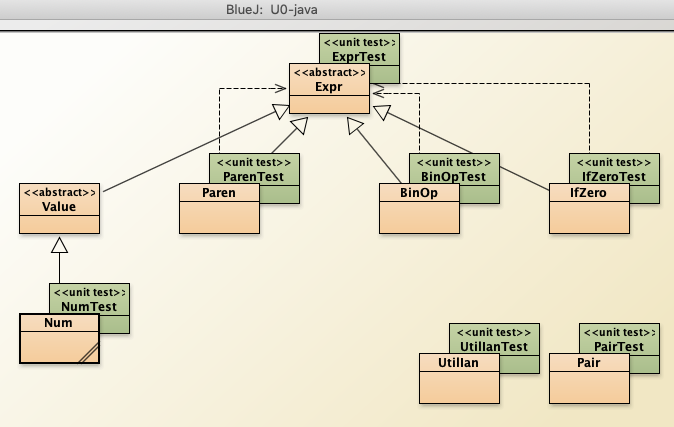

| CS 380 |
| 2024fall |
| ibarland |
 |
 |
|
Note: Download the racket files, and then choose Open… from DrRacket. Do not copy/paste into an empty DrRacket window, since that window is probably using a student-language, and some of the files below use full racket.
Java records: Remember: records are just classes where you don't have to declare the constructor, nor override .equals or .hashCode. All fields are immutable and have a public getter, though we won't need those.

 Java with sealed classes, all in a single file!
This alternate OG0 java implementation
(browsable-files,
.jar) is
similar to above, but instead of needing to edit
a different file for each Expr variant
(Num's eval in one file, and BinOp's eval
in another file, etc.),
you can put all the eval code for all variants
in the single file "OG"-java-sealed/"OG".java,
just like we did in our racket code.
Java with sealed classes, all in a single file!
This alternate OG0 java implementation
(browsable-files,
.jar) is
similar to above, but instead of needing to edit
a different file for each Expr variant
(Num's eval in one file, and BinOp's eval
in another file, etc.),
you can put all the eval code for all variants
in the single file "OG"-java-sealed/"OG".java,
just like we did in our racket code.<Expr> → <Num> | <Paren> | <BinOp> | <IfZero> | <Nop> <Paren> → bruh <Expr> slaps Interpretation: a parenthesized expression <BinOp> → finna <Op> <Expr> <Expr> Interpretation: apply a binary operator <Op> → rizz | drip | glow up Interpretation: addition, subtraction, multiplication (resp.) <IfZero> → no cap? <Expr> ong <Expr> bet <Expr> Interpretation: if 1st-expr is 0 (within 1e-6?), eval to 2nd-expr, else 3rd-expr.OG0:
<Op> → … | cancel Interpretation: “remainder1” <Expr> → … | <IfGE> Interpretation: “if less-than” <IfGE> → vibe check <Expr> low-key <Expr> ong <Expr> bet <Expr> Interpretation: if 1st Expr is >= 2nd, result is the 3rd Expr else the 4th.OG1:see OG2.html for details
OG2:see OG2.html for details
<Expr> → … | <FuncExpr> | <FuncApplyExpr> <FuncExpr> → iso <Id> wya <Expr> Interpretation: a function-value, with parameter <Id> and body-<Expr>. <FuncApplyExpr> → ohio <Expr> swoop <Expr> Interpretation: apply a function (1st expr) to an argument (2nd expr)OG4:see OG4.html for details
<Num> is any numeric literal
(as written in either Java or Racket, your choice2).
We'll assume that <Id>s are not one of our OG0 reserved words
(like vibe check
— i.e. a terminal in the above grammar);
you don't need to check/enforce that in your code.
Some similar(??) languages: Implementing one's own language (including let-expressions and functions) is a fairly standard exercise. For example, see Brown University's Programming Languages and Interpretation (Shriram Krishnamurthi), and Virginia Tech's OpenDSA Programming Languages textbook. Feel free to skim or read those books, esp. if wanting a different explanation from the notes in this class & its assignments.
Some similar(??) languages:
- emojicode
- Arnold[Schwarzenegger]C
- Genesis, in Old Hebrew
Once we've talked in class about internal-representation (and given examples of the W programs and corresponding internal-data), then we can discuss the provided-implementation, including recursive-descent parsing:
2018 version: The videos below are based on 2018fall's language, T0. So details of the syntax are different than this semester, and some statements might have different semantics, but overall the content is extremely similar to this semester's language.
todo-ibarland: Post the 2021-spring Y0-java/ upload version that uses lambda in BinOp#eval?
Note: Parsing OG0 is particularly easy because each expression-type's leading-token lets us know exactly what to expect, removing the need for look-ahead, backtracking, or cleverer algorithms.
Similarly, if using Java, the semantics of OG0's arithmetic will be similar to IEEE floating point arithmetic (rather than perfectly-correct arithmetic).
Don't confuse OG0's class Num (which extends Expr) with the existing java.lang.Number, which doesn't extend Expr.
↩This page licensed CC-BY 4.0 Ian Barland Page last generated | Please mail any suggestions (incl. typos, broken links) to ibarland |